Ventilation clamp - types and purpose
The ventilating collar is an important fastening element of air ducts and other elements of ventilating systems. Moreover, it can perform a variety of functions, respectively, it can be of different designs. In this article, we consider the most common types of such fasteners that are used when assembling air exchange systems, and their purpose.

General information
Often, home masters in installing ventilation do not pay attention to the choice of fasteners, but the quality of installation, respectively, the effectiveness and durability of the entire system depends on these parts. Moreover, in order for the clamps for the ventilation pipes to solve the tasks that are set for them, it is necessary to choose them correctly, because, as mentioned above, they may have a different design.
It should be noted that these fasteners are widespread due to a number of their advantages, such as:
- Simple locking mechanism that provides easy assembly of ventilation.
- The risk of unplanned disclosure is excluded.
- Thanks to compactness, it is convenient to carry out installation in limited space.
The standard vent clamp with a rubber band can be used to fix both vertical and horizontal structures. Therefore, we can say that such fasteners are also quite versatile.
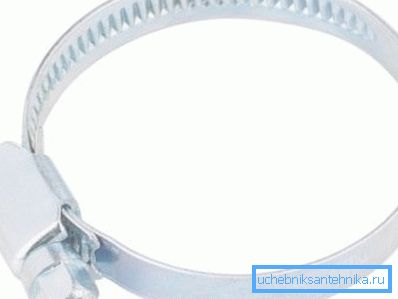
Types of fasteners
When installing ventilation most often use the following types of clamps:
| Standard | The product can be both with a sealing rubber ring, and without it, as a rule, the body is made of galvanized steel. The size is selected in accordance with the diameter of the duct. |
| Nylon | Used for fixing flexible corrugated nozzles. Products can be of different lengths and widths. The length is chosen in accordance with the diameter of the pipes and is in the range of 80 - 1220 mm. |
| Tape | The detail is made in the form of a ribbon of stainless steel with a width of 9 - 12 mm. To fix it use special clips made of stainless steel. Used for fixing flexible nozzles. |
| With rubber seal and nut | The design is made of two parts in the form of semicircles, having lugs for connecting to each other. At the top of the product there is a welded nut with which you can hang the pipes. Thus, it can be used to fix the air ducts to the walls, ceiling or floor. |
| With kombigaykoy | The design is similar to the previous one, the only one, instead of a simple nut, a welded socket is welded to it. |
| With self-tapping screw and rubber profile | The self-tapping screw allows you to attach the structure to the wall or, for example, the ceiling. Such fasteners are often used when installing chimneys and ventilation pipes. |
| Spinkler | The product is used for free suspension of air ducts. With the help of a threaded rod, you can change the height of the mount. |
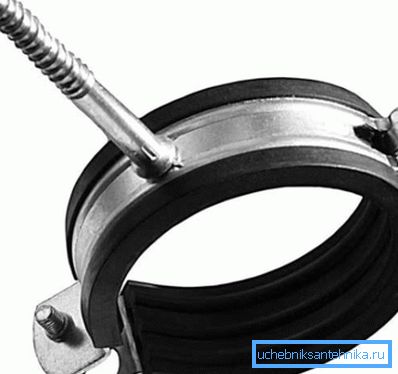
Note! Fasteners with rubber seals can reduce noise by 15 decibels, as well as reduce system vibration.
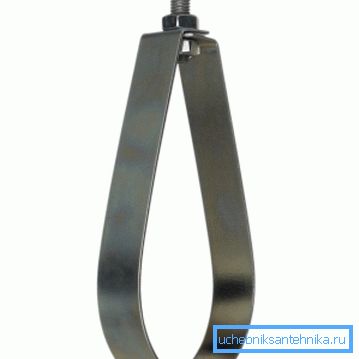
Mounting clamp
Mounting selection
Before you install the system yourself, you need to choose the right clamp.
To do this, you need to focus on the following parameters:
- Steel strip thickness;
- Width of fasteners;
- Range of permissible tightening;
- Inner diameter;
- Load capacity
Of course, structural features are also important, for example, if you just need to make a high-quality connection of two pipes, then for these purposes it is best to use a standard mount with a rubber gasket. If you need to fix the duct on the wall, you should use a design with a screw.
Note! When choosing fasteners, you should pay attention to their anti-corrosion coating, as this affects the durability of the product. In addition, it is not necessary to purchase parts, the price of which is the lowest.
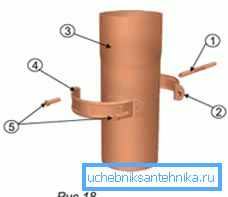
Installation
As mentioned above, the installation of fasteners on the pipe is extremely simple.
The instruction is as follows:
- If the design of the fastener is such that it does not completely unbend, then it must first be put on one of the pipes to be connected.
- Then two pipes or other parts are interconnected.
- Next, the ring must be placed at the junction of the two parts.
- After that, you need to tighten the fastener with a wrench or a screwdriver, thereby ensuring a reliable connection of parts.
If a clamp for ventilation with a self-tapping screw is installed, it is necessary first of all to fix it on the wall or ceiling, and then fix the pipe in it.
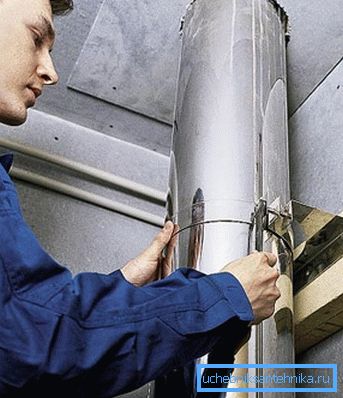
Note! When assembling ducts, you must take into account the load on the fasteners and calculate the distance between them. The maximum distance should not exceed four meters. In this case, the clamp must tightly crimp the duct to prevent its vibration.
Here, perhaps, all the important points that you need to know about the fixtures for ventilation systems.
Conclusion
At first glance it may seem that the value of the clamp in the air exchange system is not great. However, the reliability of the installation depends on the fasteners; therefore, the choice of these products should be given no less attention than other elements of the system. It is especially important that the chosen construction corresponds to the tasks assigned to it.
From the video in this article, you can learn some additional information on this topic.